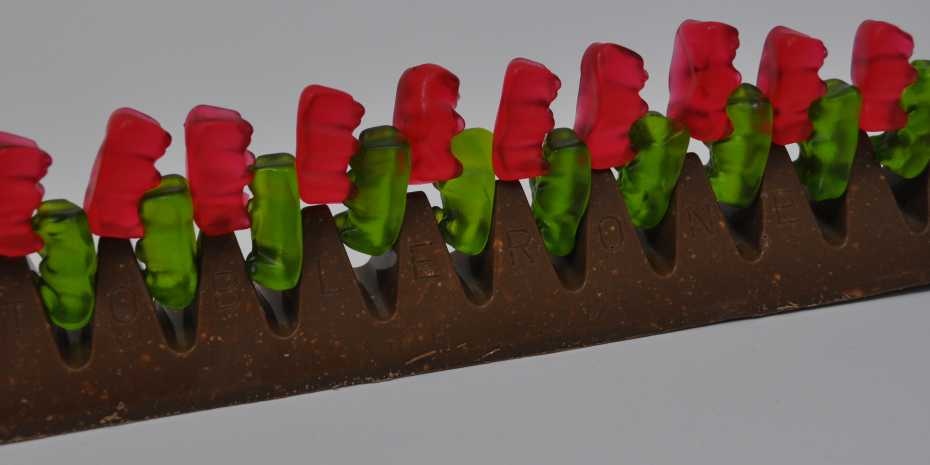Apr 2 2018
It is generally hard to estimate the behavior of electrons in a material. At present, innovative knowledge on this topic has been offered by simulations and experiments carried out by a research team headed by ETH physicists who have analyzed electronic transport characteristics in a one-dimensional quantum wire that consists of a mesoscopic lattice.
 A sweet spot for quantum particles. In a one-dimensional periodic potential, represented by the teeth and notches of a Toblerone bar, there is no free flow of electrons if exactly two of them (pictured here as pairs of gummy bears) occupy each notch, due to Pauli exclusion principle. Surprisingly, a similar insulating behavior can be observed with ultracold fermionic atoms that strongly attract each other, thus forming a so-called Luther–Emery liquid. (Image credit: Esslinger group/ETH Zurich)
A sweet spot for quantum particles. In a one-dimensional periodic potential, represented by the teeth and notches of a Toblerone bar, there is no free flow of electrons if exactly two of them (pictured here as pairs of gummy bears) occupy each notch, due to Pauli exclusion principle. Surprisingly, a similar insulating behavior can be observed with ultracold fermionic atoms that strongly attract each other, thus forming a so-called Luther–Emery liquid. (Image credit: Esslinger group/ETH Zurich)
Whether a material is, for instance, an insulator or a metal is reliant on a wide array of microscopic details, such as the number of dimensions through which the charge carriers can propagate, the presence of impurities, and the strength of interactions between electrons. This intricacy makes it very hard to estimate the electronic characteristics of solid-state systems.
Gaining in-depth knowledge of the behavior of electrons in a material becomes even harder if they move through a periodic potential, for instance, in a crystal. Subsequently, phenomena such as superfluidity, related to a large conductance, can compete with interference effects that convert the material into an insulator.
Martin Lebrat collaborated with researchers in Tilman Esslinger’s team at the Institute for Quantum Electronics of ETH Zurich and colleagues at the University of Geneva and the École Polytechnique Fédérale de Lausanne (EPFL) to overcome this problem by conducting experiments in an absolutely clean artificial material that can be controlled with higher flexibility and accuracy.
The researchers have reported in a paper published in the journal Physical Review X that they used laser light to form short one-dimensional lattice structures linked to two reservoirs of ultracold lithium-6 atoms. In this framework, the researchers can measure the conductance of the wire while perfectly controlling all relevant parameters, such as the height and length of the lattice as well as the interactions between the particles that move through it.
In the experiments, the researchers observed that a band-insulating phase with weak interactions emerged. Upon tuning the interactions from weakly to strongly attractive, they noted that the insulating state persisted, indicating the presence of a so-called Luther–Emery liquid, an original phase that was predicted in 1974 and which is a unique one-dimensional property of the structure.
The experimental study was supported by simulations. Together, these outcomes exhibit the simultaneous control of quantum interferences and interactions in cold-atom devices. This should be intriguing not just in terms of investigating the behavior of electrons traveling through materials; the flexibility offered by the strategy of Lebrat and his colleagues also means that they can develop complex structures with innovative functionalities that cannot be found in electronic systems.